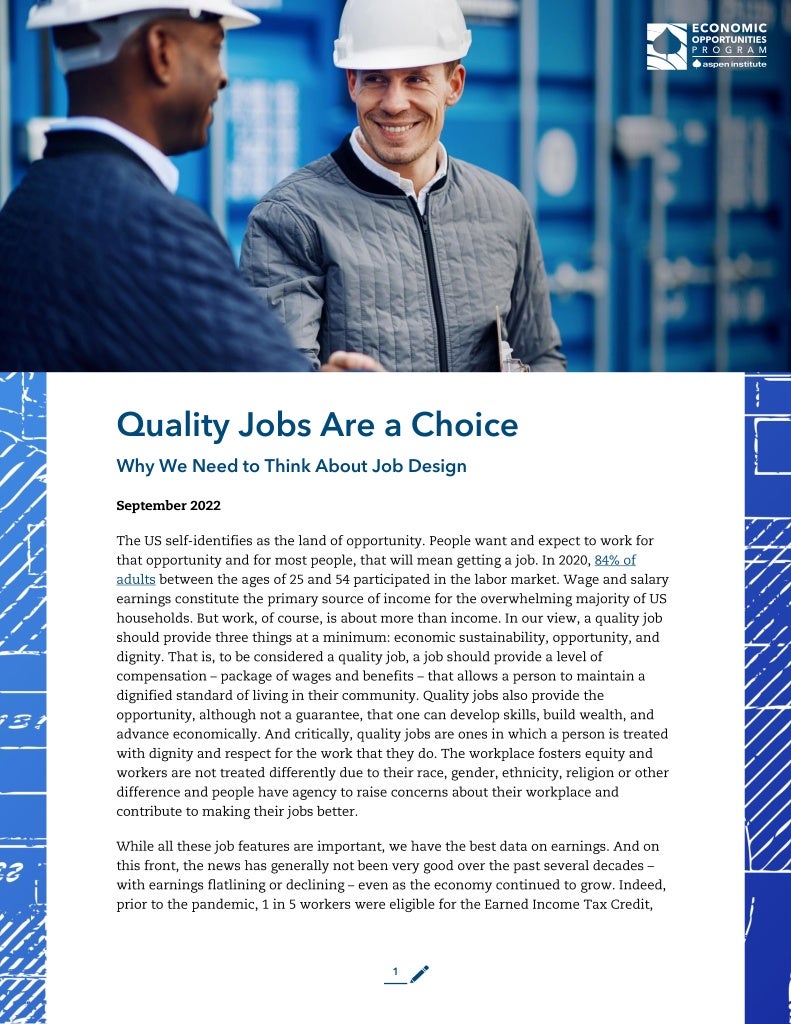Recent estimates show that about one-third of jobs pay less than $15 an hour. Many of these jobs are associated with other job quality issues such as unpredictable schedules and a lack of opportunities for advancement. Low-quality jobs such as these are not inevitable, and neither are high-quality jobs that provide good compensation, the opportunity to advance and grow, and a workplace that promotes dignity and equity. Low-quality and high-quality jobs are the result of a variety of choices that are made in designing jobs.
This issue brief reviews the history and current state of job design, highlights the benefits workers and businesses receive when jobs are designed with worker well-being in mind, and notes emerging issues and practices in job design related to technology, work-based learning, and employee ownership. We hope this brief sparks new thinking and conversations about how we can all encourage and contribute to designing work and workplaces that promote quality jobs.
Tweets
Tweet Quality Jobs Are a Choice: Why We Need to Think About Job Design.
Tweet This issue brief by @AspenJobQuality reviews the history and current state of job design — and emerging issues and practices around technology, work-based learning, and #employeeownership.
Tweet Both high- and low-quality jobs are the result of choices about how we design work — including good compensation, opportunities for advancement, and a supportive workplace. Learn more in this brief by @AspenJobQuality.
Tweet Low-quality jobs are not inevitable. We can choose to make work better. This issue brief by @AspenJobQuality highlights the benefits to workers and businesses when jobs are designed with worker well-being in mind.
The Job Quality Choice: Opportunities and Challenges in Job Design
Each day, approximately 160 million people in the US go to work. Many of them will work in a job or workplace designed to meet the needs of the employer with little thought given to what employees may need to be successful, or how the success of employers and workers are connected. The results of our country’s collective approach to job design are well documented at this point. Almost one-third of workers in the US – a disproportionate number of whom are women and people of color – earn less than $15 an hour, and over 50% of the jobs projected to be created between 2020 and 2030 will pay less than a living wage. But, wages are just one part of job design. Many of these low-paying jobs also don’t offer personal fulfillment, opportunities for worker input and voice, advancement, skills development, benefits, or other qualities of good jobs.
The evidence is also clear that bad jobs resulting from poor job design are not inevitable, but are reflective of choices we make. Employers in every industry and across every occupation have demonstrated that designing good jobs is possible and beneficial to workers and employers. What can these employers and businesses teach us about job design? What incentivizes and inhibits the design of quality jobs? And what role does philanthropy and government have in helping employers to design good jobs? Join the Aspen Institute Economic Opportunities Program for this mini-series, The Job Quality Choice: Opportunities and Challenges in Job Design, where we will explore the drivers of job design, examine current challenges and opportunities around issues such as technology, skills development, and worker voice, and discuss strategies and practices that create good jobs that help workers and businesses succeed together.
- Part I: For Better or Worse: Designing Jobs During Technological Change — July 27
- Part II: Opportunity by Design: A Discussion on Growing Worker Skills and Talent in the Workplace — September 14
- Part III: Job Design and Employee Ownership — Date TBD
Learn more
The Economic Opportunities Program advances strategies, policies, and ideas to help low- and moderate-income people thrive in a changing economy. Follow us on social media and join our mailing list to stay up-to-date on publications, blog posts, events, and other announcements.


